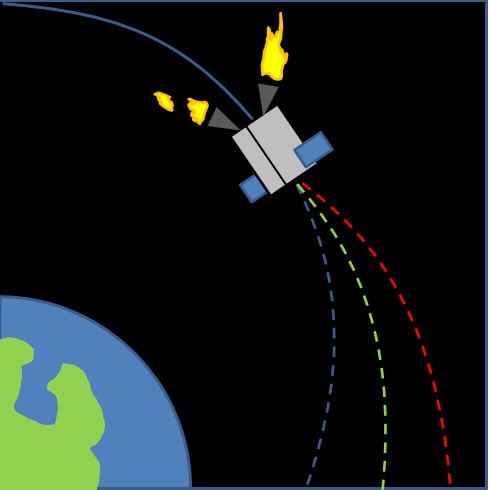East–West GEO Satellite Station-Keeping with Degraded Thruster Response
Abstract
:1. Introduction
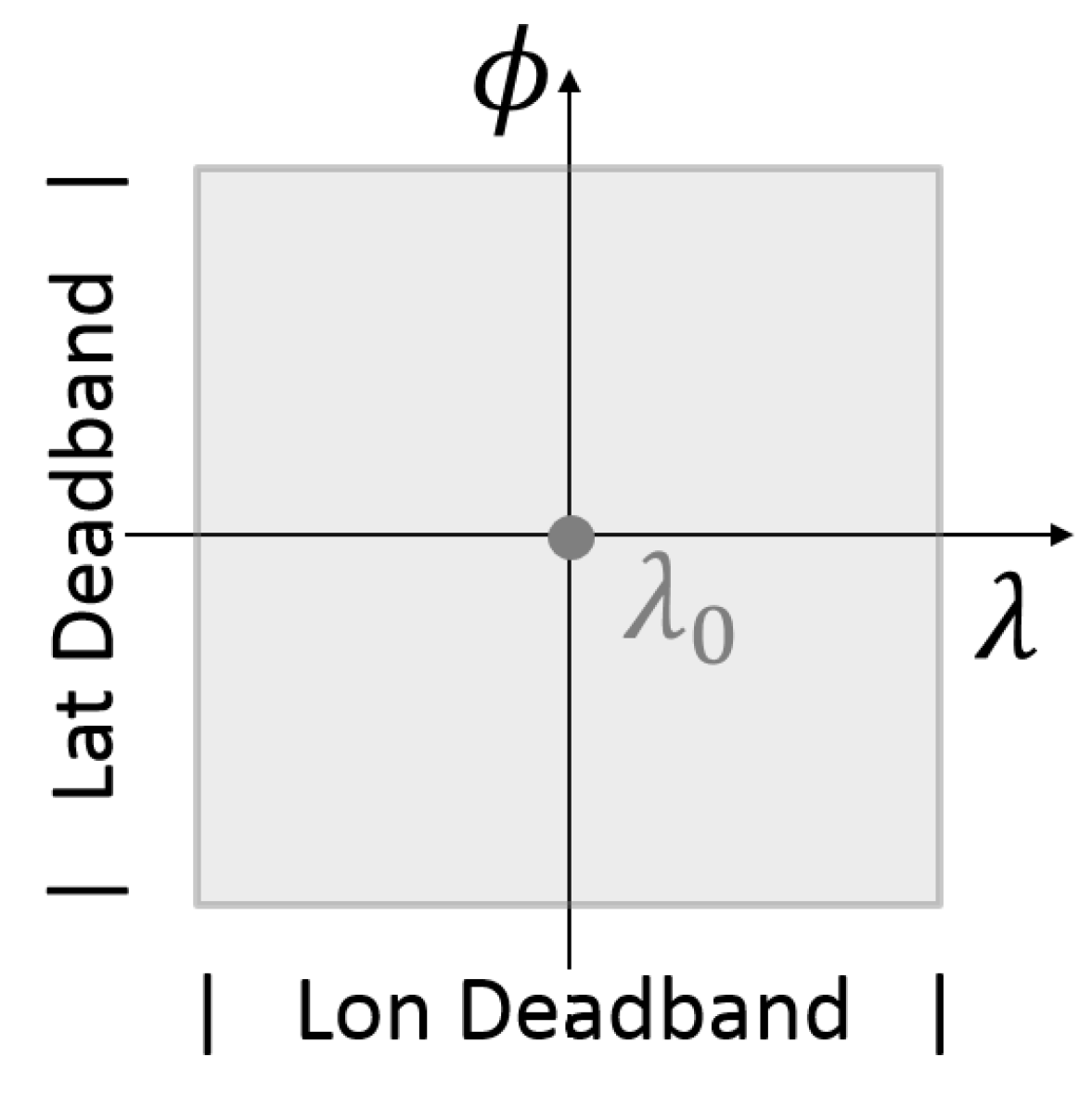
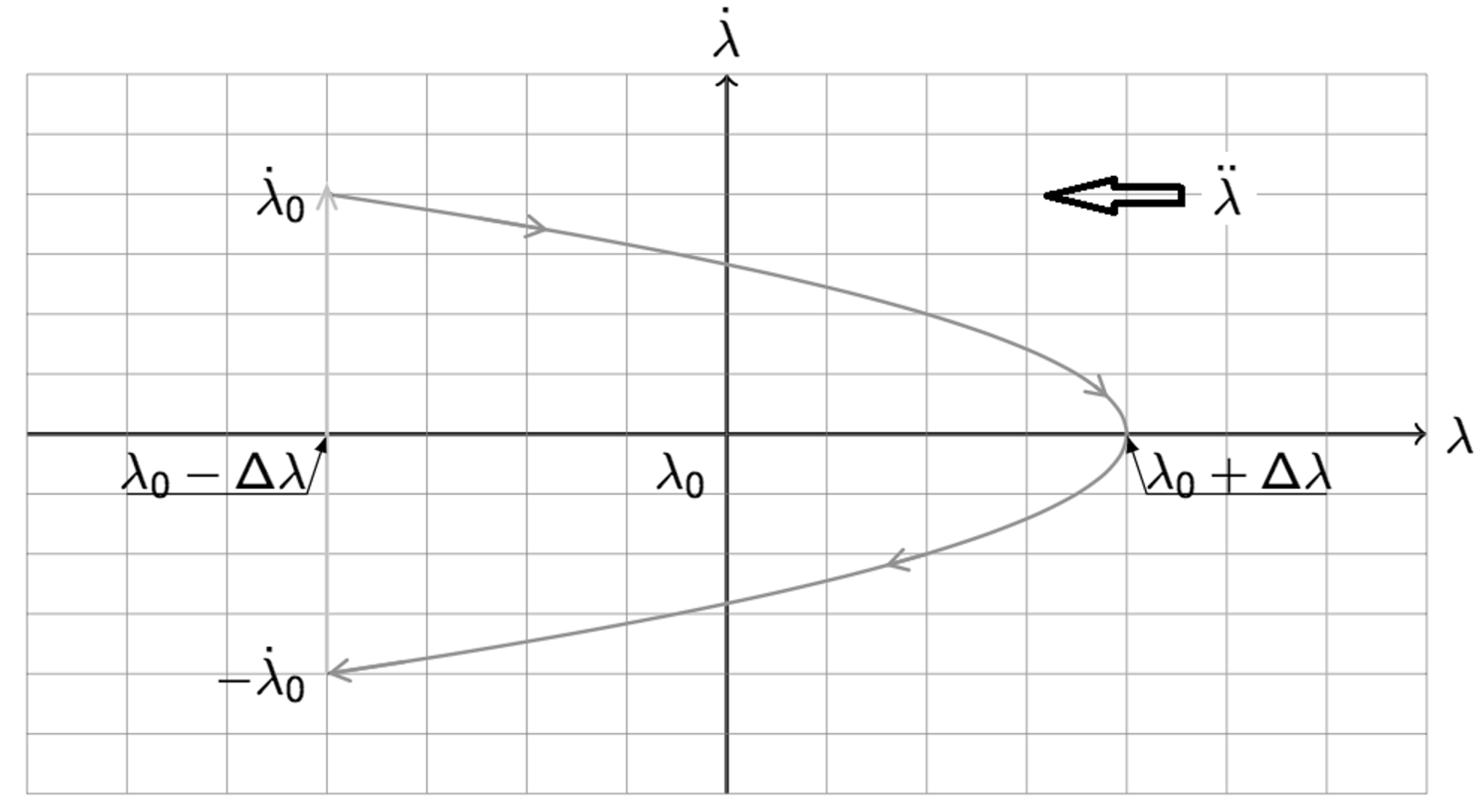
- Modeling the effect of degraded thruster response on longitudinal station keeping;
- The new control approach is more complex and, therefore, is at higher risk of performing the wrong maneuvers;
- The number of satellite operations increases, as well as extra work is required from ground operators;
- In some cases, the thrusters generate unexpected orbital deviations; in these cases, the on-board program must be able to eventually interrupt and alter the control strategy;
- Orbital elements and satellite dynamics must be tracked during and between maneuvers in order to ensure correct station keeping.
2. Nominal East–West GEO Satellite Drift
2.1. Longitudinal “Deadband”
2.2. Lagrange’s Equations of Drift Rate
2.3. Nominal Single E–W Maneuver
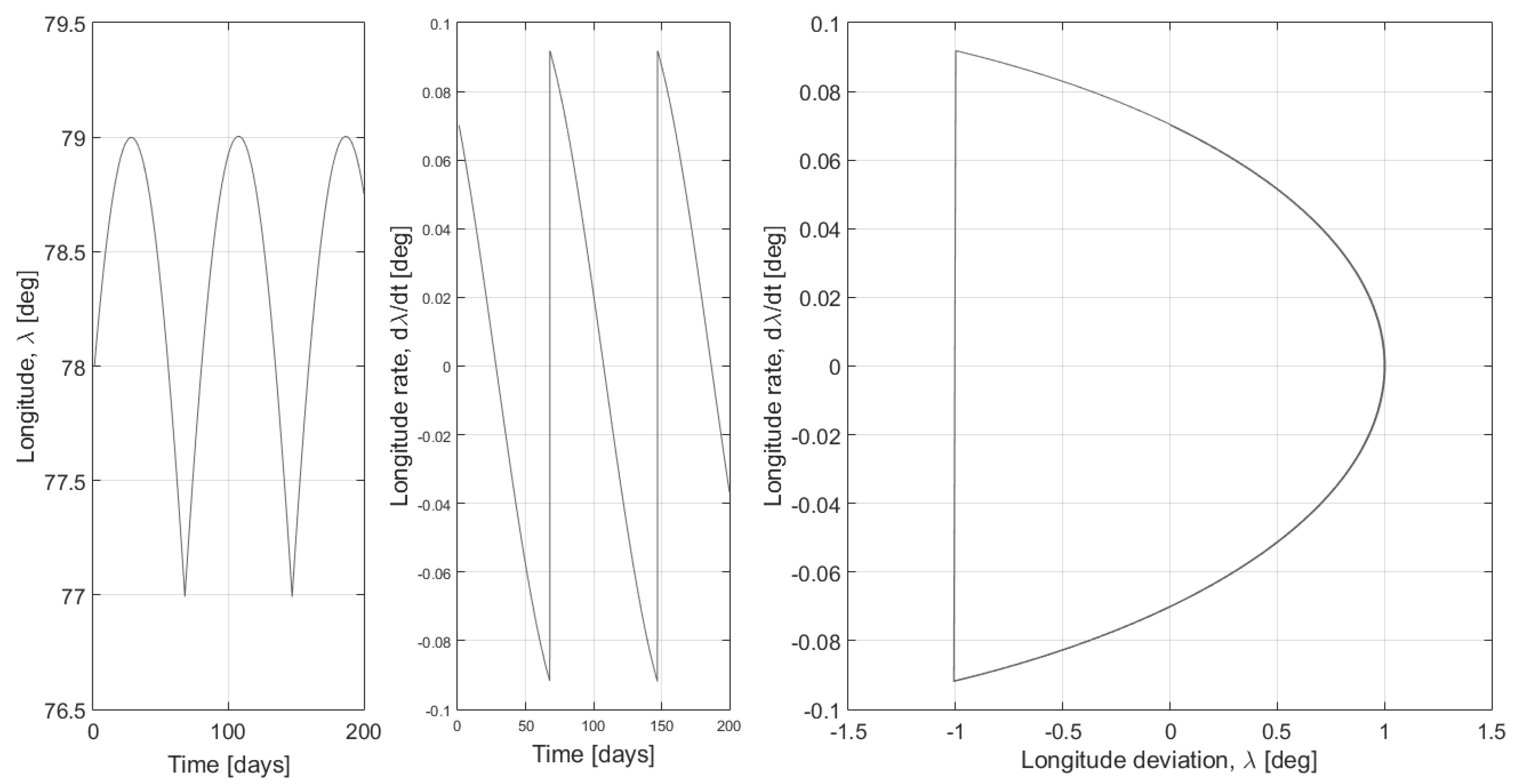
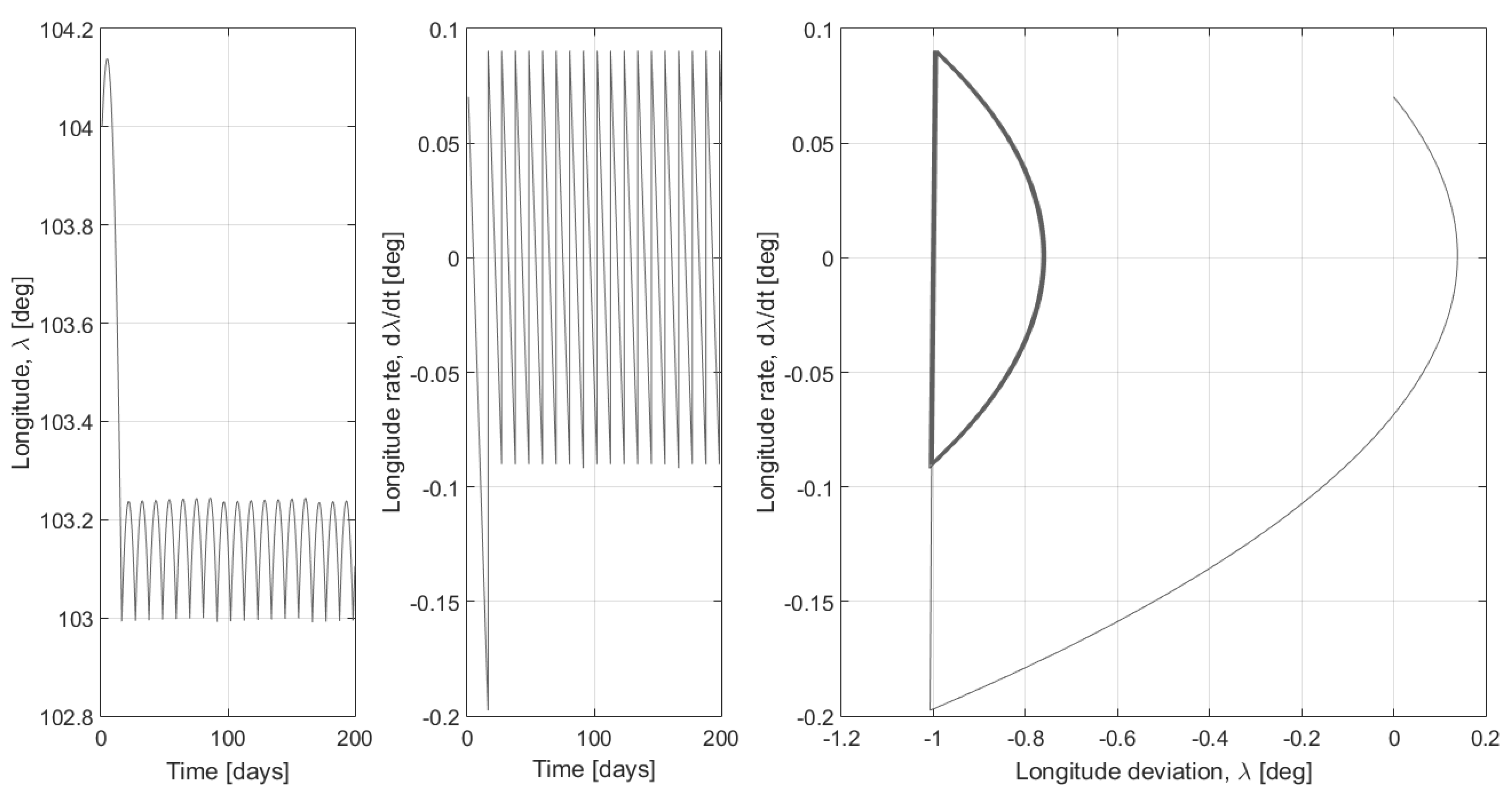
2.4. Station-Keeping Strategy Using a Degraded E–W Thruster
- Step 1: Station-keeping. In this phase, the on-board control thrusters execute the orbital maneuvers to keep the GEO satellite in its assigned deadband. These maneuvers can be evaluated on-board or at ground stations.
- Step 2: Longitude drift. In this phase, the GEO satellite, subject to the Earth’s tesseral harmonics, drifts in its longitude toward east or west, depending on where the closest stable longitude point sits.
- Step 3: Orbit measurements. In this phase, all of the input data for the orbit determination algorithms are measured. These measurements can be obtained by ground-based observers, telescopes or radars. These data usually consist of time, azimuth, elevation, range and/or range rate. Usually, to obtain enough accuracy for orbit determination, measurements should be taken over at least one full day.
- Step 4: Orbit determination. Specific orbit determination algorithms are used to estimate the orbit. These algorithms can be run on the ground or simplified versions can be run on-board. The difference between the expected orbit (before the impulse) and the measured orbit (after the orbit determination phase) constitutes the error. The analysis of this error then dictates the next station-keeping strategy as more reliable knowledge is obtained on the effectiveness of the thrusters.
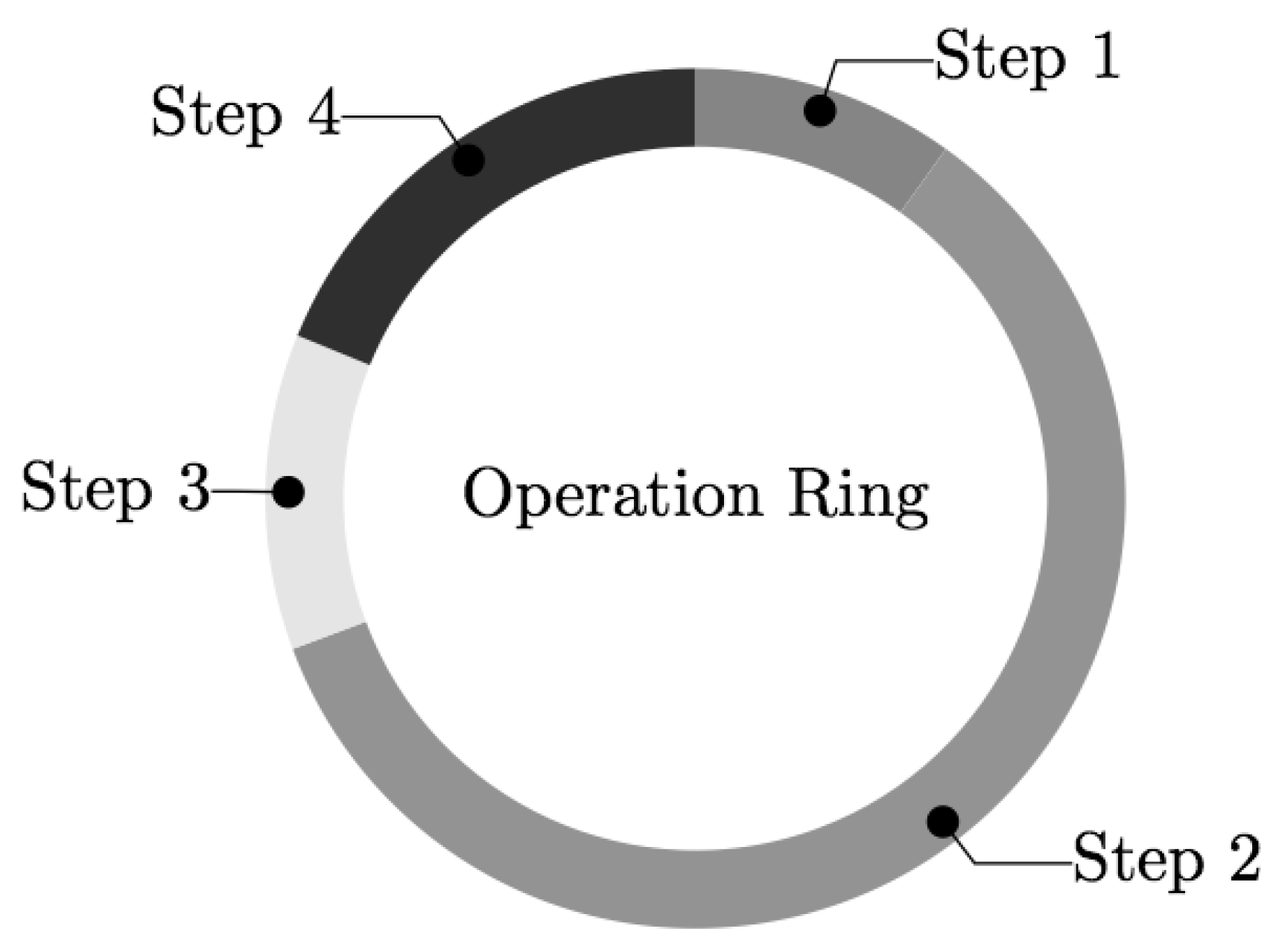
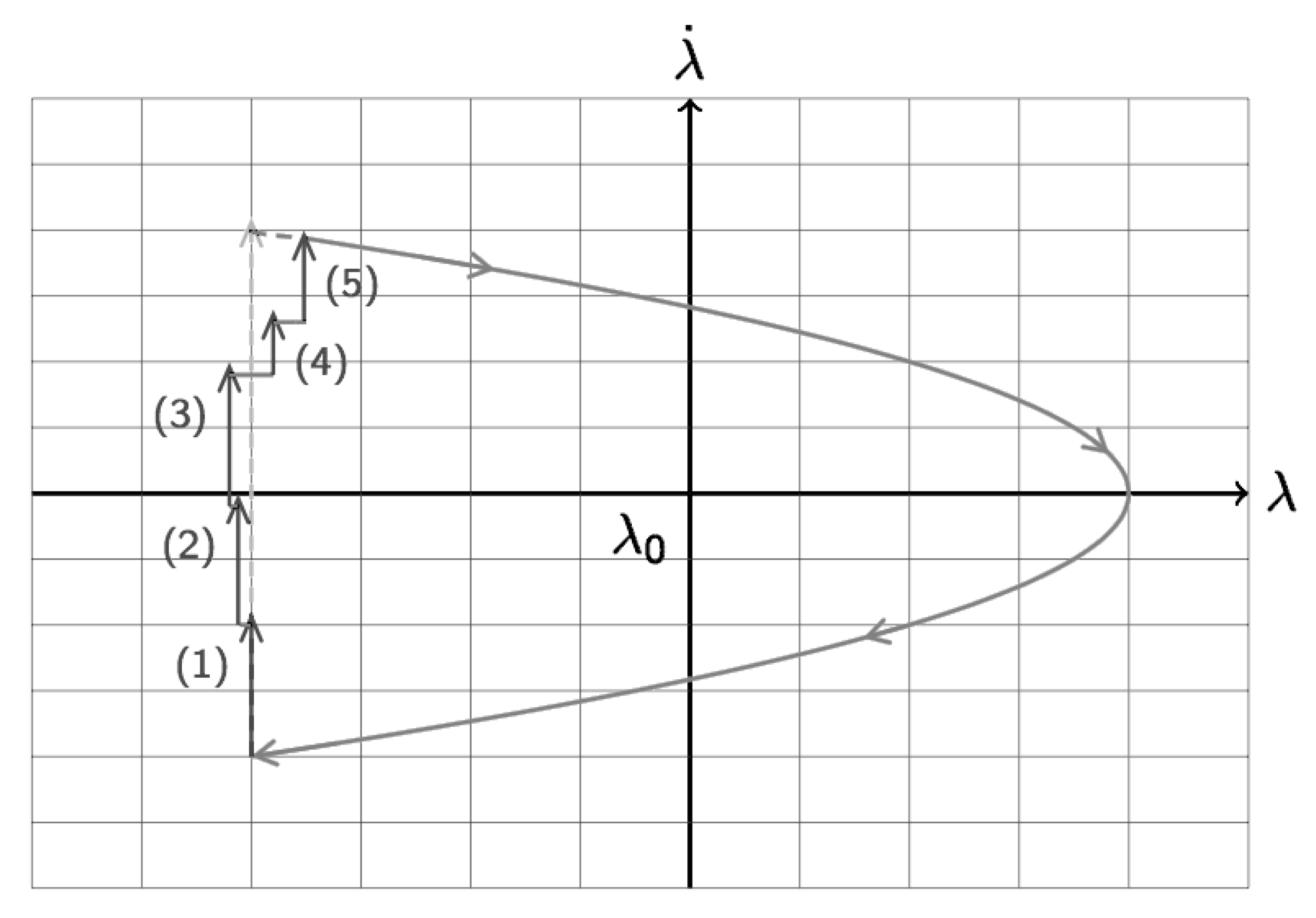
2.5. Control Equations of the E–W Maneuver
3. Degraded Thruster Response
3.1. Comparison of the Time-Domain Output of the Thruster Pulse

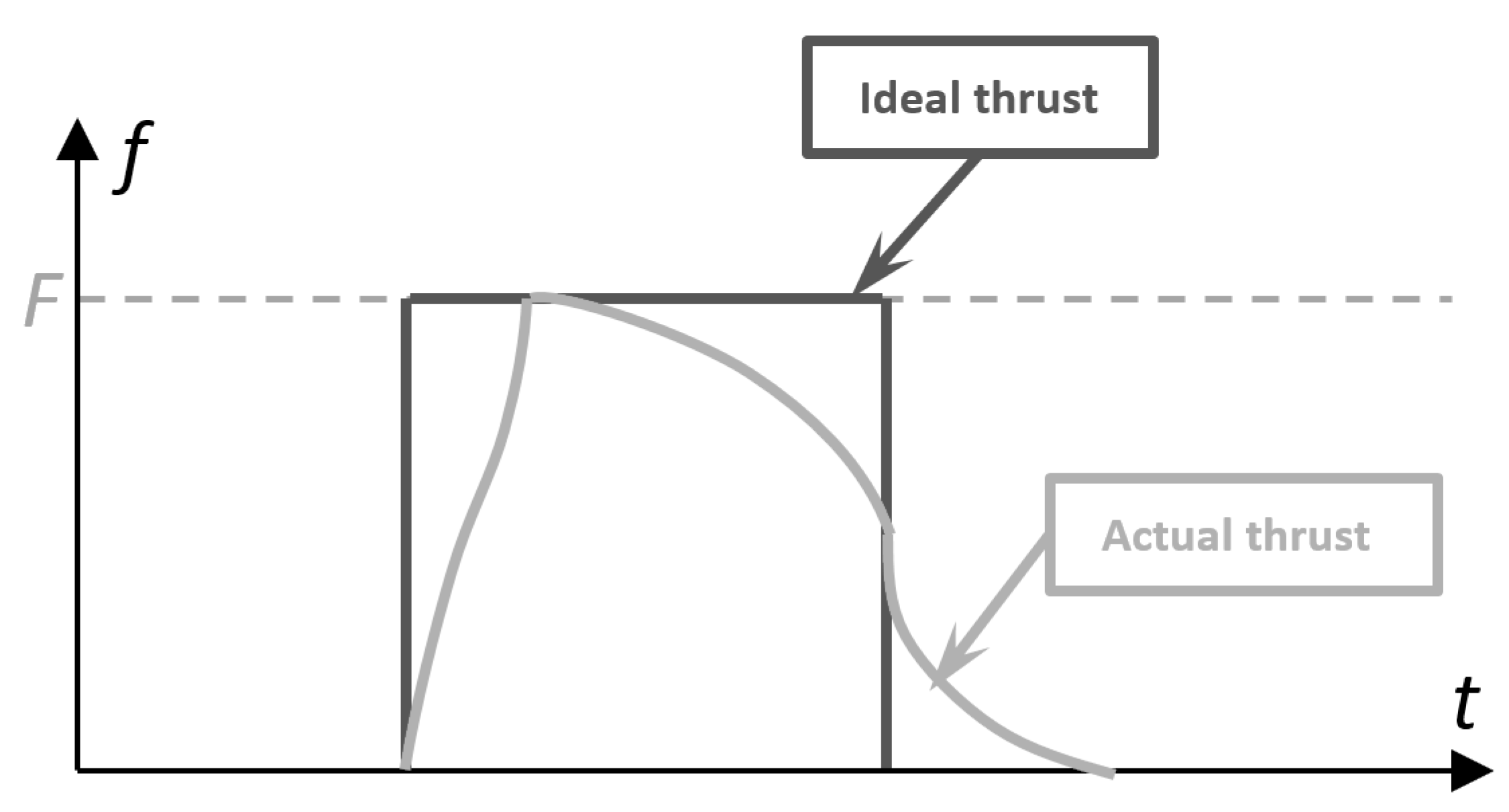
3.2. E–W Maneuver with Degraded Thruster Response
4. Attitude Dynamics of the Momentum-Biased GEO Satellites
4.1. Momentum-Biased Wheel Configuration
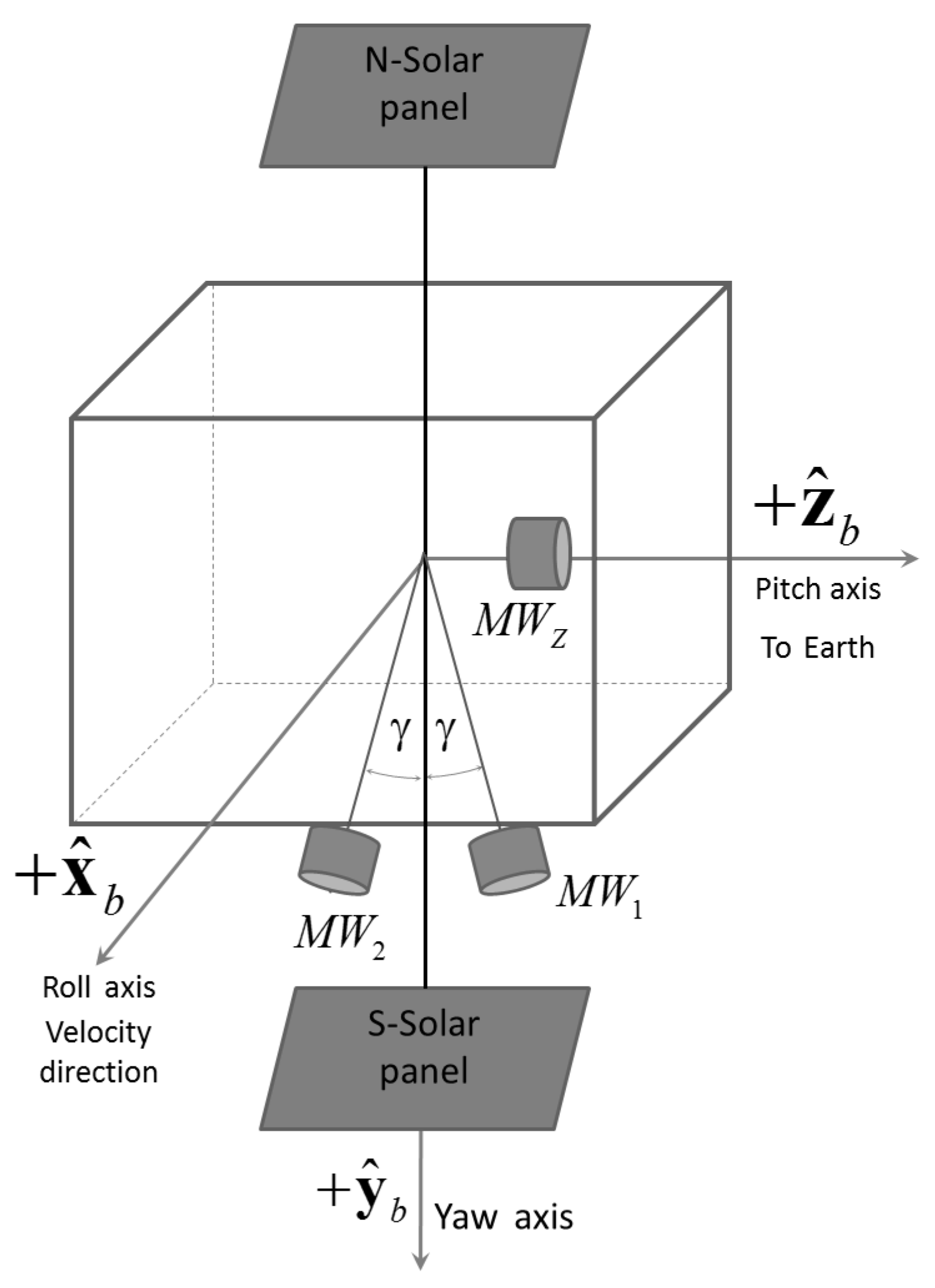
4.2. Orbital Element Estimation Based on the Angular Momentum Wheel Variations
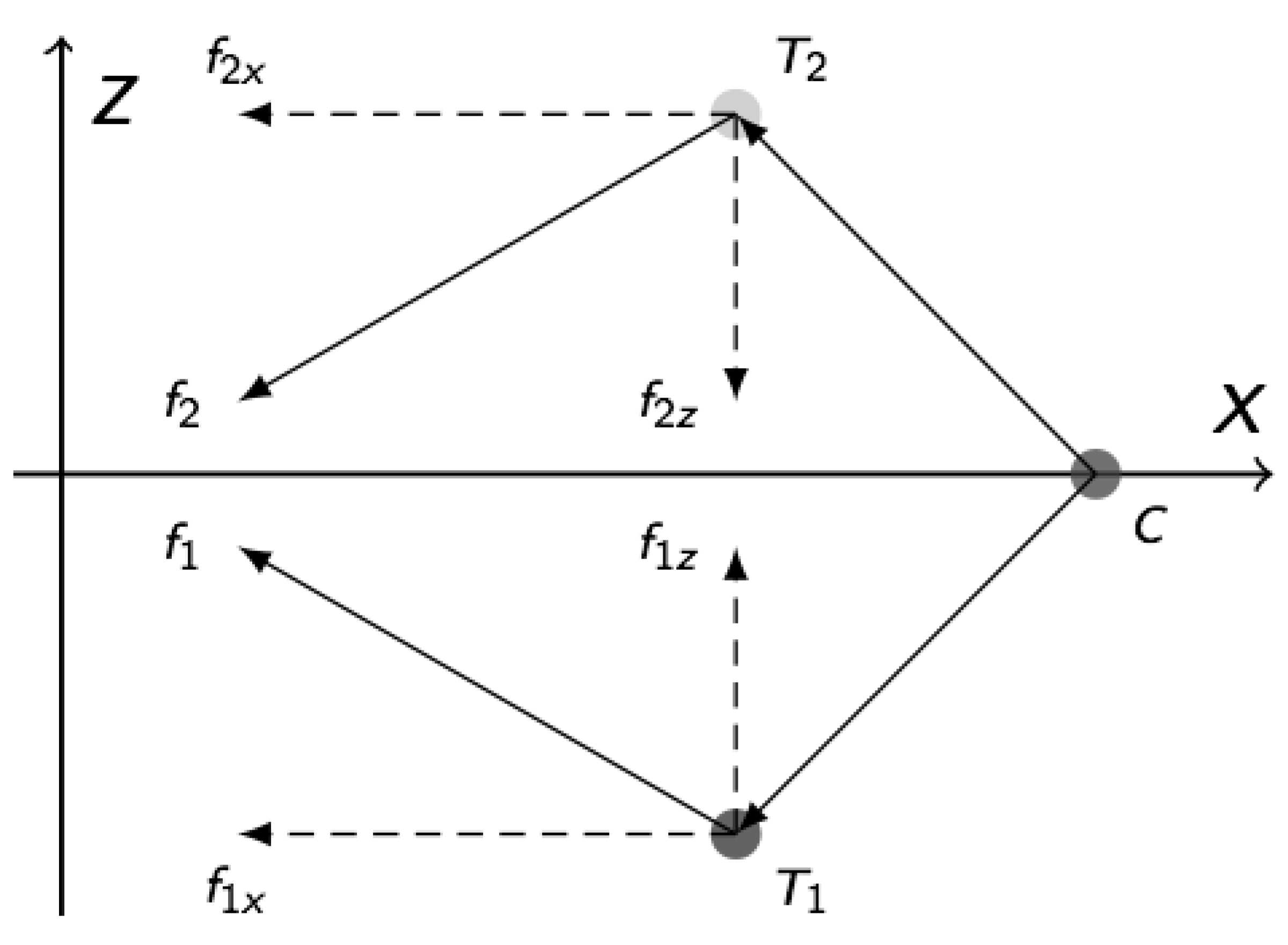
5. Simulation Case
- Scenario and inputs: Let us adopt the following values for the purposes of simulation: mean east longitude = 80.0 E, satellite mass = 2400 kg, cross-sectional area = 10 m and reflectivity constant = 1.85. The momentum biases in the wheels, and , have both been determined to be 10 N·m·s; the installation inclination angle is a reasonable choice. To provide momentum bias attitude control, the momentum wheels are spun with an angular velocity of 1000 rpm, which is inside the permitted bounds for the MWs. A reaction bipropellant low-thrust system consists of two 10 N thruster pairs. Illustrated in Figure 11, the thrusters are arranged so that they provide the necessary torques for attitude control about the three body axes, as well as the necessary thrust for station keeping. Thruster pairs of and , and are used for E–W (longitude) station keeping and also for eccentricity corrections. Thrusters and provide the positive and the negative yaw control torques respectively about the axis; likewise, thrusters and yield the positive and the negative torques individually about the axis.
- Dynamics: From Equation (4), we can obtain the longitude drift acceleration, deg/day. Then, we calculate the needed from Equation (8) for the entire sequence of corrections. This is useful for giving a rough estimate for how much fuel will be spent during the maneuvering sequence. Substituting all constants into Equation (34) and simplifying, we obtain km, km. We also get the desired correction in longitude drift rate . After each thruster firing, and will be measured, and and will be calculated and used to determine how much more correction is needed.
- Thruster control: According to Euler’s moment equations, a thruster pulse in the correct direction from thruster or can increase the angular momentum of spacecraft about the or axis. With no active attitude control, the body accumulates angular velocity as the angular momentum of the spacecraft increases, changing the attitude of the spacecraft. However, if momentum wheels are used to stabilize the attitude, then the accumulated angular momentum will be transferred to the wheels. As shown in Figure 12, alternating the ignition of thruster or will produce cyclic variations in MW speed. In Figure 12, the lighter solid line indicates the increasing MW speed when fires, and the dark line is the decreasing MW speed when fires. and are the speed limits corresponding to the control overshoot limits and . Figure 13 demonstrates that the evolution of the yaw is bounded by the thrusting maneuvers. Therefore, it is possible to implement thruster attitude control while still keeping MW speed within acceptable bounds. The measured change in wheel speed induced by thruster firing can then be used to calculate the variation in the semi-major axis. Furthermore, this method works even under degraded thruster response.The whole process is shown in Table 1; a longitudinal or east–west thrust changes both the longitudinal drift rate and the eccentricity of the orbit. The net semi-major axis variation is km, which produces a drift rate of deg/day. The maneuver provides good longitudinal correction while also ensuring that the attitude remains within bounds.

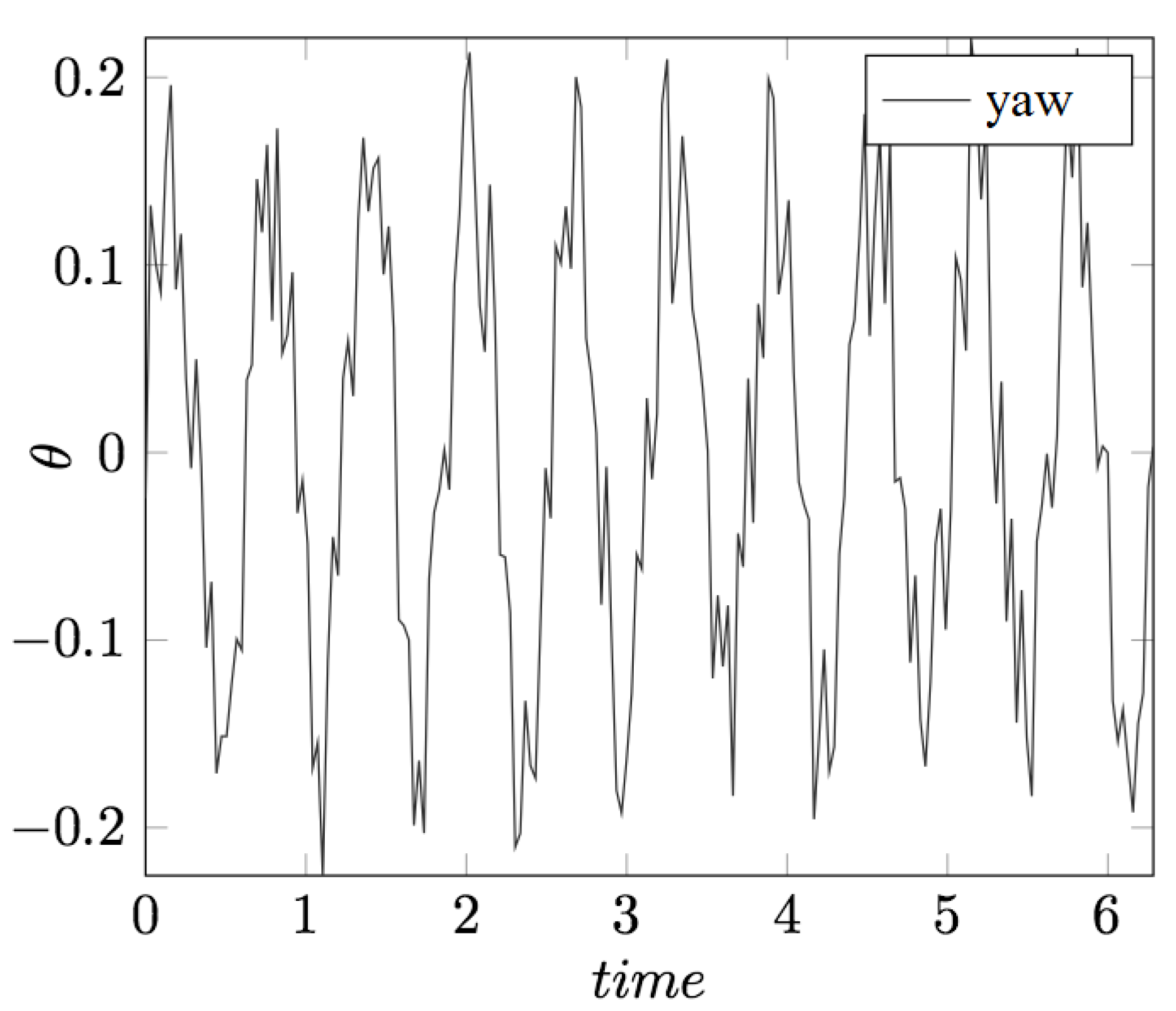
| Firing | Thruster | ||||
|---|---|---|---|---|---|
| (rpm) | (km) | (deg/day) | |||
| 1 | T2 | 1000 | |||
| 2 | T1 | 1000 | |||
| 3 | T2 | 1000 | |||
| 4 | T1 | 1000 | |||
| 5 | T2 | 1000 | |||
| 6 | T1 | 1000 | |||
| 7 | T2 | 1000 | |||
| 8 | T1 | 1000 | |||
| 9 | T2 | 503 |
6. Workflow
- Step 1: Preliminary spacecraft tracking gives initial data consisting of range (ρ) and/or antenna angles azimuth (), elevation () measured from one or more ground stations at discrete time points. The range rate () is of less interest for geostationary orbits. The precisely-determined and predicted orbit can be estimated using the most recent available tracking data.
- Step 2: Subsequently, the prescribed longitude boundary must be used to design the E–W station-keeping maneuver. From the prescribed longitude boundary, the thruster ignition start time , the change of the semi-major axis , the executed velocity increment , the mean fuel consumption and other variables are calculated. Performing longitude maneuvers near apogee (or perigee), we can prevent eccentricity from becoming too great due to a single thrust. At the beginning, some short impulses (quarter or half width) are fired to evaluate the thrusters’ performance and to calibrate the system.
- Step 3: Next, Figure 14 gives the workflow for performing station keeping assuming nominal thruster performance. At the start time , thruster pair , fires. In order to prevent large yaw attitude errors, the yaw θ must be monitored. Thruster firing must be modified when thruster performance is degraded. A modified workflow assuming degraded thruster performance is shown in Figure 15. The main difference between the nominal and modified workflow is marked with dark grey. Instead of simultaneous firing of thrusters and , firing is alternated, while keeping angular wheel velocity between the lower and upper bounds. Furthermore, in order to prevent the wheel momentum from approaching the permitted limits, the length of single thruster firings must be confined. Moreover, the workflow loop termination condition is affected by how far is from its desired value.
- Step 4: In the end, for orbit re-estimation, the new orbital elements can be determined from the latest tracking data. Through data post-processing, the updated orbital , D and can be used to estimate the effect of the maneuver. Finally, the next station-keeping maneuver can be started with a new thruster firing scheme.
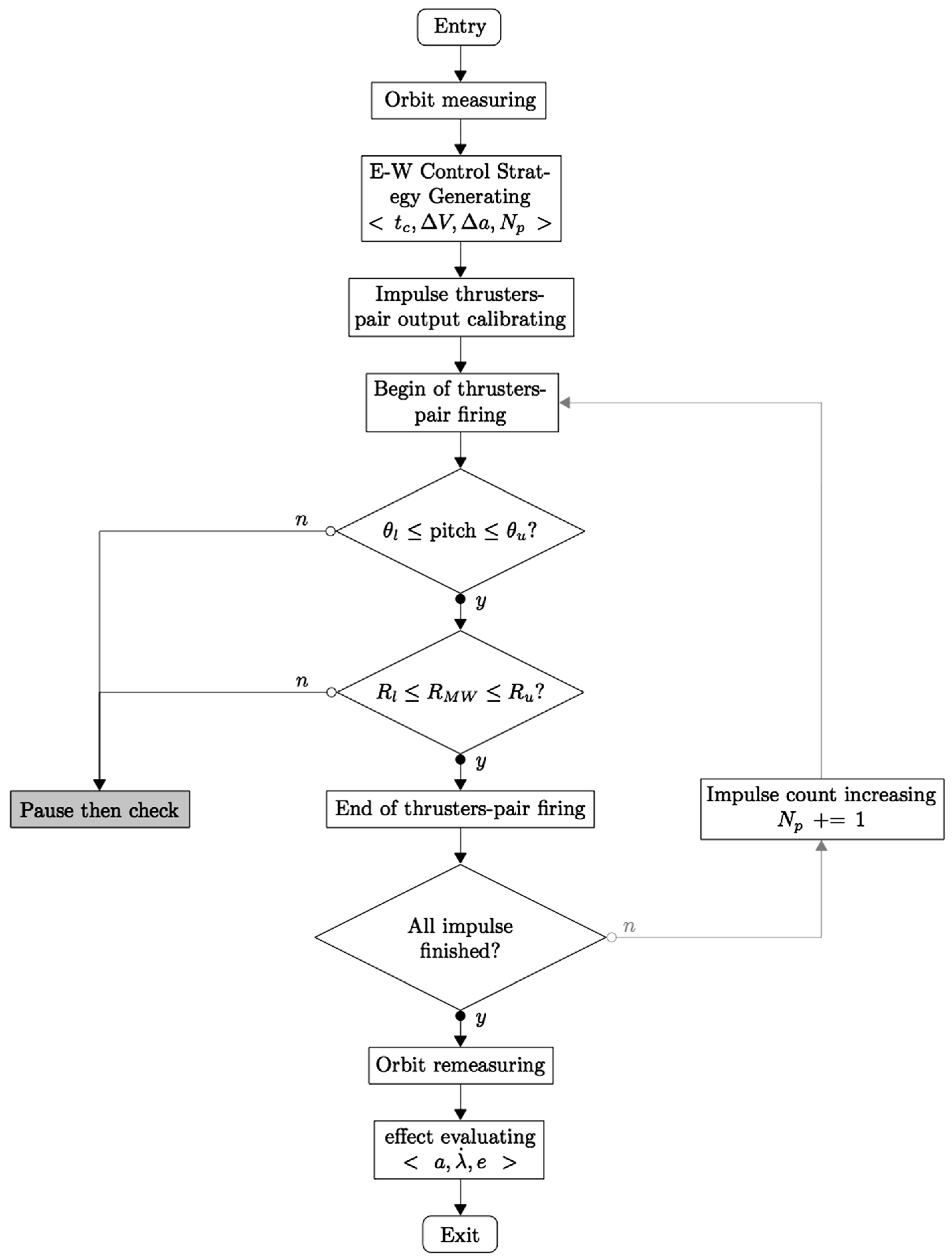
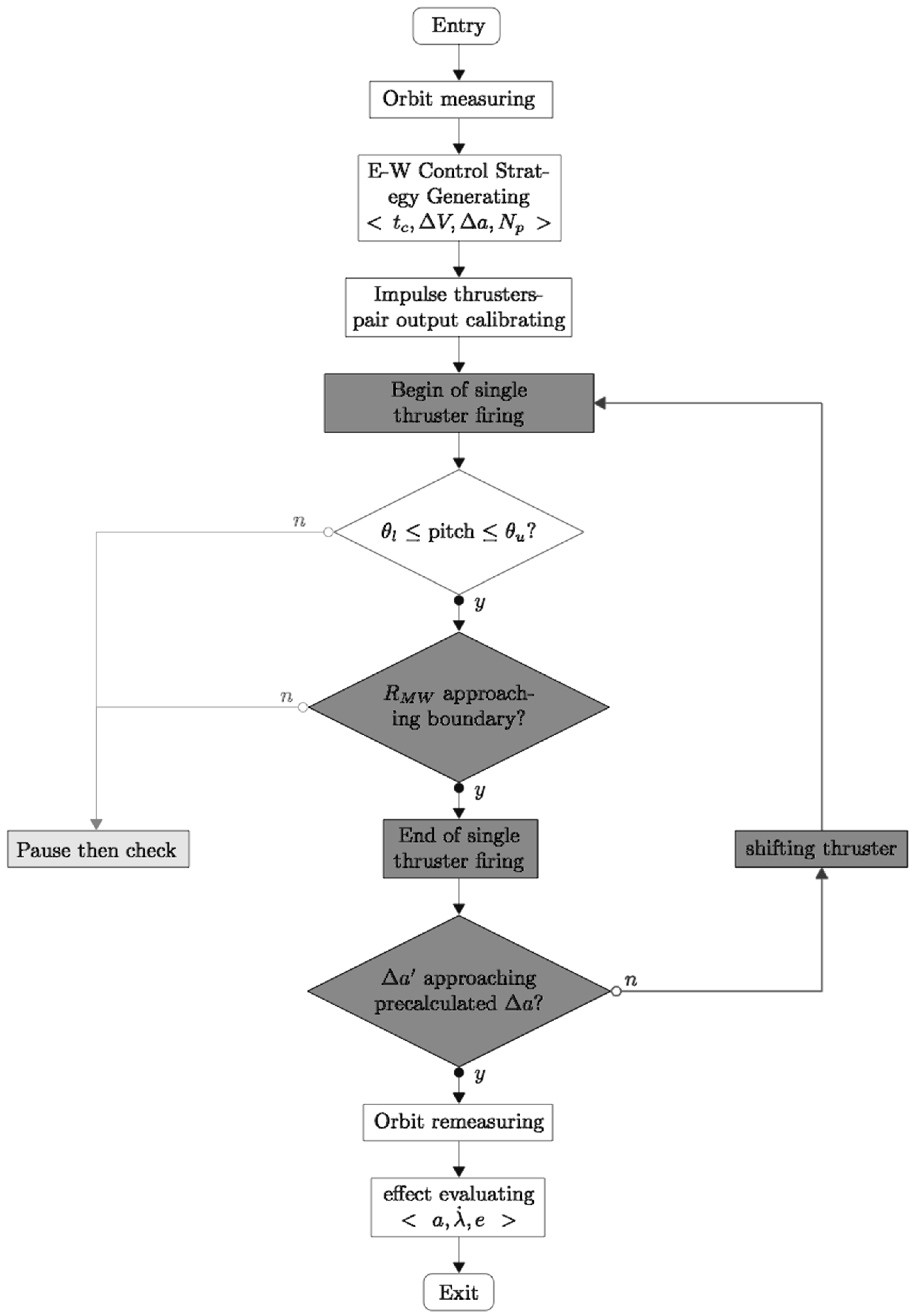
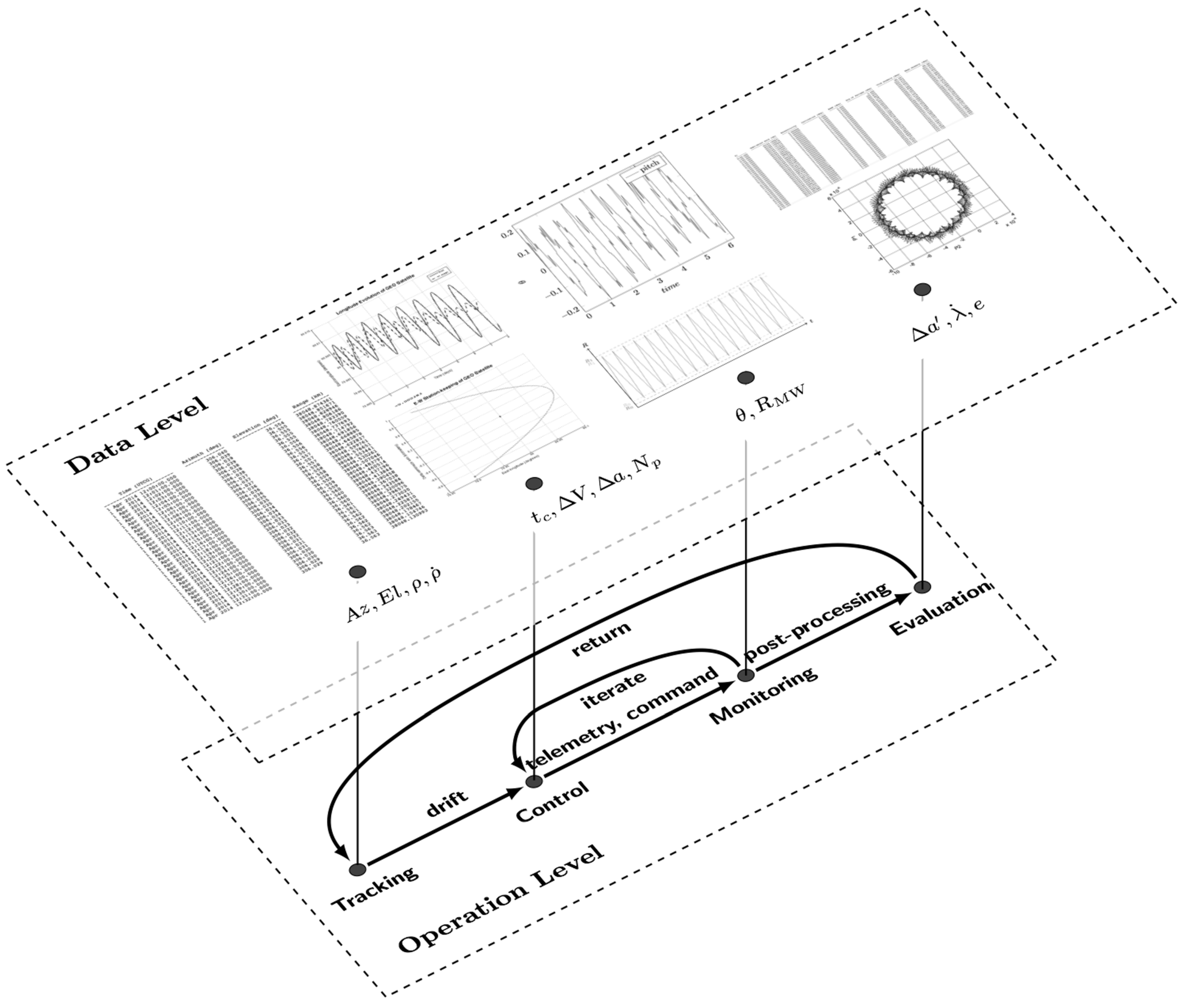
7. Conclusions
Author Contributions
Conflicts of Interest
References and Notes
- Circi, C. Simple Strategy For Geostationary Stationkeeping Maneuvers using Solar Sail. AIAA J. Guid. Control Dyn. 2005, 28, 249–253. [Google Scholar] [CrossRef]
- Shrivastava, S.K. Orbital Perturbations and Stationkeeping of Communication Satellites. J. Spacecr. Rockets 1978, 15, 67–78. [Google Scholar] [CrossRef]
- Lee, B.S.; Hwang, Y.; Kim, H.Y.; Park, S. East–West Station-Keeping Maneuver Strategy for COMS using Iterative Process. Adv. Space Res. 2011, 47, 149–159. [Google Scholar] [CrossRef]
- Romero, P.; Gambi, J.M. Optimal Control in the East–West Station-Keeping Manoeuvres for Geostationary Satellites. Aerosp. Sci. Technol. 2004, 8, 729–734. [Google Scholar] [CrossRef]
- This problem affects all satellites on compatible orbits (also called resonant orbits) and GEO satellites are in the 1-1 compatible orbit.
- Ostrander, N.C. Longitudinal Station Keeping of Nearly Geostationary Satellites; Rand Corporation: Santa Monica, CA, USA, 1969. [Google Scholar]
- Soop, E.M. Handbook of Geostationary Orbits; Springer: Dordrecht, The Netherlands, 1994; Volume 3. [Google Scholar]
- Crouch, P.E. Spacecraft Attitude Control and Stabilization: Applications of Geometric Control Theory to Rigid Body Models. Trans. IEEE Autom. Control 1984, 29, 321–331. [Google Scholar]
- Hardacre, S. Control of Colocated Geostationary Satellites; Cranfield University: Bedford, UK, 1996. [Google Scholar]
- Hughes, P. Spacecraft Attitude Dynamics; Courier Dover Publications: Mineola, NY, USA, 2012. [Google Scholar]
- Romero, P.; Gambi, J.M.; Patiño, E. Stationkeeping Manoeuvres for Geostationary Satellites using Feedback Control Techniques. Aerosp. Sci. Technol. 2007, 11, 229–237. [Google Scholar]
- Sidi, M.J. Spacecraft Dynamics and Control: A Practical Engineering Approach; Cambridge University Press: Cambridge, UK, 1997; Volume 7. [Google Scholar]
© 2015 by the authors; licensee MDPI, Basel, Switzerland. This article is an open access article distributed under the terms and conditions of the Creative Commons Attribution license (http://creativecommons.org/licenses/by/4.0/).
Share and Cite
Borissov, S.; Wu, Y.; Mortari, D. East–West GEO Satellite Station-Keeping with Degraded Thruster Response. Aerospace 2015, 2, 581-601. https://doi.org/10.3390/aerospace2040581
Borissov S, Wu Y, Mortari D. East–West GEO Satellite Station-Keeping with Degraded Thruster Response. Aerospace. 2015; 2(4):581-601. https://doi.org/10.3390/aerospace2040581
Chicago/Turabian StyleBorissov, Stoian, Yunhe Wu, and Daniele Mortari. 2015. "East–West GEO Satellite Station-Keeping with Degraded Thruster Response" Aerospace 2, no. 4: 581-601. https://doi.org/10.3390/aerospace2040581
APA StyleBorissov, S., Wu, Y., & Mortari, D. (2015). East–West GEO Satellite Station-Keeping with Degraded Thruster Response. Aerospace, 2(4), 581-601. https://doi.org/10.3390/aerospace2040581






